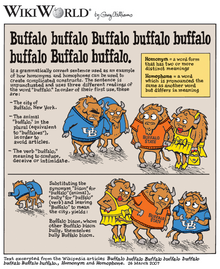Buffalo buffalo Buffalo buffalo buffalo buffalo Buffalo buffalo
" Buffalo buffalo Buffalo buffalo buffalo buffalo Buffalo buffalo. “Is a grammatically correct sentence in English. It is a common example of how complex sentences can be formed from a homophonic or homonymous expression due to polysemy .
background
Translated into German is the sentence: " Buffalo from Buffalo , the buffalo from Buffalo bullied are bully Buffalo from Buffalo." He used "buffalo" in the meanings <Bison (plural)>, <city Buffalo> and <deceive, mislead to hunt in the fenugreek [Am.] ›( to buffalo ).
Word Ways editor Dmitri Borgmann as well as William J. Rapaport, professor at the University at Buffalo, The State University of New York and Annie Senghas, a former student of Steven Pinkers, are named as authors of the sentence .
See also
- List of repeated words
- In the English-speaking world, the phrase " James while John had had had had had had had had had had a better effect on the teacher " is also known, which is also largely composed of a single ambiguous word that is used repeatedly .
- In Swedish there is a sentence that consists exclusively of the repetition of a single syllable: “Bar barbar-bar-barbar bar bar barbar-bar-barbar”, in German something like: “A naked barbarian from a bar for barbarians wore one naked barbarians from a bar for barbarians. "
- In several Scandinavian languages, a well-known tongue twister begins with the sentence "Far, får får får?", Which despite different spellings only consists of syllables that sound the same. It ends with the answer "No, får får ikke får, får får lam."
- The German equivalent usually needs at least an introduction: "When flies fly behind flies, flies fly flies after", "When seals crawl behind seals, seals seal seals afterwards", "When crickets grill, grill grill, grill grill" or "With seven seven seven seven dwarfs flour ”. But it also works without: “Carry Carry Carry, Carry Carry Carry” or “Soft, soft, soft, soft, soft, soft”.
- A construct of noun phrase and prepositional phrase, consisting only of “in” and “der”: “The Indian in the Indian woman.” Similarly: “Bismarck bit Mark, until Mark Bismarck bit”.
- A variant is the combination of two words with an introductory word: "If elves help elves, elves help elves help."
- The following example comes from the quiz game Trivial Pursuit : The question is: “Which German sentence contains nine times and and is still correct?” Then the answer: “Between 'nine times' and' and 'and' and 'and' and 'and' and 'and' is' are each a space. "
- A sentence with six times "that (s)" is: "The teacher said that the 'that' that the girl wearing the green dress had written on the board was wrong" and a sentence with six times "shop": "Worker who shop in a chocolate shop invite shop girls to take a stroll. "
- Zhao Yuanren's text " Lion-Eating Poet in the Stone Cave " consists of 92 times the syllable "shi", but with different tones .
- The Japanese emperor Saga is said to have tested the scholar Ono no Takamura with the following pun in the early 9th century , whether he could read it: 子 子 子 子 子 子 子 子 子 子 子 子 . Only one character is used here, but it is read differently: in the Kun reading ne for the Chinese zodiac sign of the rat, in the usual Kun reading ko for "child", and in the On reading shi or inside the word voiced as ji . It follows then neko no ko koneko, shishi no ko kojishi ( "The child of a cat is a kitten, the child of a lion is a lion cub"), normally with appropriate characters as 猫の子子猫,獅子の子子獅子 written would be.
Web links
Individual evidence
- ^ A. Ross Eckler, Jr .: The Borgmann Apocrypha . In: Word Ways: The Journal of Recreational Linguistics . tape 38 , no. 4 , November 2005, pp. 258-260 ( butler, edu ).
- ↑ Dmitri A. Borgmann: Beyond Language: Adventures in Word and Thought . Charles Scribner's Sons , New York, NY, USA 1967.
- ^ A b William J. Rapaport: A History of the Sentence 'Buffalo buffalo buffalo Buffalo buffalo.' Ed .: University at Buffalo Computer Science and Engineering. October 5, 2012 ( buffalo.edu [accessed December 7, 2014]).
- ↑ Steven Pinker. The Language Instinct: How the Mind Creates Language , William Morrow and Company, Inc., New York, 1994. p. 209

